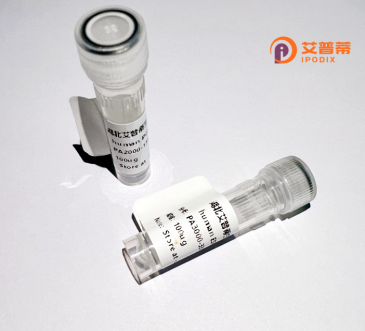
| 纯度 | >90%SDS-PAGE. |
| 种属 | Human |
| 靶点 | SPAG4 |
| Uniprot No | Q9NPE6 |
| 内毒素 | < 0.01EU/μg |
| 表达宿主 | E.coli |
| 表达区间 | 1-379 aa |
| 活性数据 | MPRSSRSPGDPGALLEDVAHNPRPRRIAQRGRNTSRMAEDTSPNMNDNILLPVRNNDQALGLTQCMLGCVSWFTCFACSLRTQAQQVLFNTCRCKLLCQKLMEKTGILLLCAFGFWMFSIHLPSKMKVWQDDSINGPLQSLRLYQEKVRHHSGEIQDLRGSMNQLIAKLQEMEAMSDEQKMAQKIMKMIHGDYIEKPDFALKSIGASIDFEHTSVTYNHEKAHPYWNWIQLWNYAQPPDVILEPNVTPGNCWAFEGDRGQVTIQLAQKVYLSNLTLQHIPKTISLSGSLDTAPKDFVIYGMEGSPKEEVFLGAFQFQPENIIQMFPLQNQPARAFSAVKVKISSNWGNPGFTCLYRVRVHGSVAPPREQPHQNPYPKRD |
| 分子量 | 67.21 kDa |
| 蛋白标签 | GST-tag at N-terminal |
| 缓冲液 | PBS, pH7.4, containing 0.01% SKL, 1mM DTT, 5% Trehalose and Proclin300. |
| 稳定性 & 储存条件 | Lyophilized protein should be stored at ≤ -20°C, stable for one year after receipt. Reconstituted protein solution can be stored at 2-8°C for 2-7 days. Aliquots of reconstituted samples are stable at ≤ -20°C for 3 months. |
| 复溶 | Always centrifuge tubes before opening.Do not mix by vortex or pipetting. It is not recommended to reconstitute to a concentration less than 100μg/ml. Dissolve the lyophilized protein in distilled water. Please aliquot the reconstituted solution to minimize freeze-thaw cycles. |
以下是关于重组人SPAG4蛋白的3篇文献摘要概览:
---
1. **文献名称**: *SPAG4 promotes prostate cancer progression via MEK/ERK/c-Jun pathway*
**作者**: Li H, et al.
**摘要**: 本研究探讨了SPAG4在前列腺癌中的作用,发现其过表达通过激活MEK/ERK/c-Jun信号通路促进肿瘤增殖和转移,而重组SPAG4蛋白被用于体外实验验证其对细胞侵袭的调控机制。
---
2. **文献名称**: *Recombinant human SPAG4 as a potential biomarker in hepatocellular carcinoma*
**作者**: Zhang Y, et al.
**摘要**: 研究通过纯化重组SPAG4蛋白并进行血清学分析,发现其在肝癌患者中表达显著升高,且与肿瘤分期正相关,提示其可能作为肝癌诊断或预后标记物。
---
3. **文献名称**: *Structural and functional characterization of SPAG4 in sperm flagellar formation*
**作者**: Wang X, et al.
**摘要**: 利用重组SPAG4蛋白解析了其在精子鞭毛组装中的功能,发现其通过与微管蛋白相互作用调控鞭毛结构完整性,缺失实验显示精子运动能力受损。
---
4. **文献名称**: *SPAG4 interacts with HPV E6 oncoprotein to promote cervical cancer progression*
**作者**: Chen L, et al.
**摘要**: 研究发现SPAG4通过重组蛋白互作实验与HPV E6蛋白结合,协同增强宫颈癌细胞增殖并抑制凋亡,揭示了SPAG4在HPV相关癌症中的新机制。
---
以上研究涵盖了SPAG4在肿瘤生物学和生殖系统中的功能及重组蛋白的应用。如需完整文献信息,建议通过PubMed或期刊数据库检索具体DOI。
The recombinant human SPAG4 (sperm-associated antigen 4) protein, also known as HSSG1. is a member of the SUN (Sad1/UNC-84) domain-containing protein family. Primarily associated with spermatogenesis, SPAG4 plays a critical role in nuclear envelope organization, chromosomal dynamics, and cell division by interacting with other nuclear membrane proteins. Its conserved SUN domain facilitates connections between the nucleoskeleton and cytoplasmic cytoskeletal components, contributing to proper meiosis and mitosis. Beyond reproductive biology, recent studies implicate SPAG4 in cancer progression, where its overexpression correlates with poor prognosis in malignancies like cervical, ovarian, and hepatocellular carcinomas. The protein is thought to promote tumor cell proliferation, migration, and invasion through pathways involving EMT (epithelial-mesenchymal transition) and Wnt/β-catenin signaling. While primarily studied in germ cell development, SPAG4's roles in somatic cells remain under investigation, with emerging links to DNA repair and cellular stress responses. Recombinant SPAG4 serves as a tool for elucidating its biochemical properties and interactions, particularly in dissecting SUN domain-mediated nuclear-cytoplasmic communication. Its dual implications in fertility and oncology highlight SPAG4 as a potential biomarker or therapeutic target, though mechanistic details require further exploration.
×